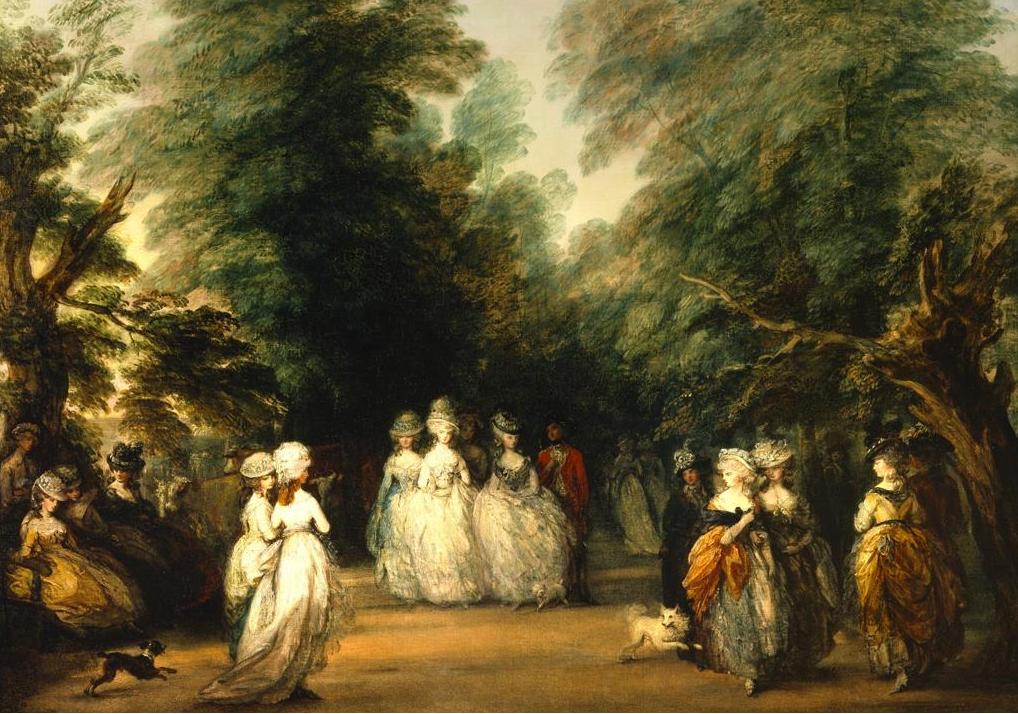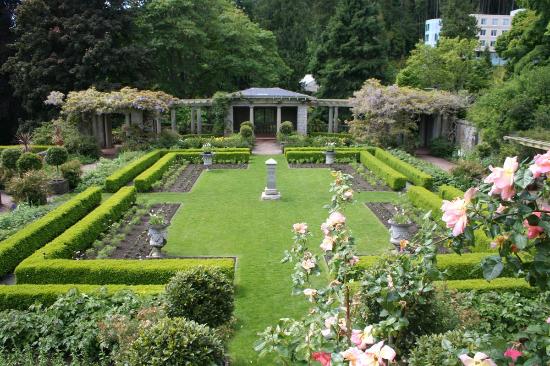The great change in European gardens came with the Renaissance , that sudden astonishing growth of man’s spirit which carried him forward into the daylight of intellectual confidence. He is no longer comforted with the little shut-in plots that have comforted him through all the dark centuries of his history till now. He feels himself suddenly magnificent.

---Spring time was a great time to head to the promenade in the 18th century. There were promenades such as thePromenade de Longchamps in France and the famous Ranelagh Gardens in England. Ladies of society would wear their finest walking gowns and new hats, to be seen and discussed. A famous portrait by Gainsborough depicts non other than the Duchess of Devonshire herself walking along the Mall in St. James's Park with pup in tow, alongside (probably) her fashionable sister. --- Read More:http://marie-antoinettequeenoffrance.blogspot.com/2010/04/promenade-in-style.html
And from these modest enclosures of flowers he makes gardens which are magnificent too. For Renaissance gardens are no longer mere homes for plants, they are works of art, architectural constructions that use vegetation as their building material. The plants have no longer any personality of their own; they are there to fill the places allotted to them in the design. Trees and shrubs are not valued for their beauty but because they will stand constant clipping, and flowers are chosen for their neat and disciplined growth. They are none of them there for their own green sakes but as malleable material for man’s own self-expression.

Italian Garden. Read More:http://blog.lib.umn.edu/willow/bioart/2009/10/emily-berlin--centuries-old-bio-art.html
Renaissance gardening is one of the fine arts, and best considered not as gardening at all but as a form of stately ceremonial music, a superb overture to the palaces it surrounds and the princely life for which it is the background. The gardens are not designed by gardeners but by architects, sculptors, painters- by the great names of the Renaissance- and Le Notre himself was trained as an architect before he turned to gardens for his material.

---The Italian Renaissance Garden is "An interpretation of the 15th-16th Century Renaissance Gardens that sought to rationalise and improve upon nature". Very stylised, this seemed almost the opposite of the Chinese Garden. At one end of this garden is a balcony overlooking the Waikato River. With almost no signs of human habitation visible on its banks at this point, this makes an impressive outlook. --- Read More:http://danny.oz.au/travel/nz2005/hamilton-gardens.html
For the gardens which were created in England and France in the late sixteenth, seventeenth, and eighteenth centuries are no longer simple detached enclosures without relation to the house they serve. Renaissance man was confident with a new sense that he controlled his world as a whole, was triumphantly master of his environment. So garden and house are laid out together, doors and windows open freely onto courtyards and terraces, and these continue into the garden by noble staircases and open walks and long vistas.
But this superb control was not learned all at once. In his essay On Gardens, Francis Bacon makes the following observation:G0D Almighty first planted a garden. And indeed it is the purest of human pleasures. It is the greatest refreshment to the spirits of man; without which, buildings and palaces are but gross handiworks; and a man shall ever see, that when ages grow to civility and elegancy, men come to build stately sooner than to garden finely; as if gardening were the greater perfection. Read More:http://www.authorama.com/essays-of-francis-bacon-46.html
In the early Renaissance we can see how true is Bacon’s judgement. The new style of palaces is already well developed while the gardens which surround them are still no more than a series of the little enclosed plots we know already, numbers of them merely laid out side by side till the ground is covered.
But these are Renaissance gardens. The bricks they are built with may be old fashioned, but the conception is new. The garden is not yet controlled as the unified whole which Le Notre will create later on in France, but already there are avenues, vistas, a progression from noe part to t
ext, and above all the house merges with the setting.
Like the rest of the arts the Renaissance garden first blossomed around Florence, but Rome soon followed the new fashion and the Italian princes outdid each other in laying out splendid pleasure grounds. The popes and cardinals especially were most ambitious planners in this grandiloquent new style.









 COMMENTS
COMMENTS



